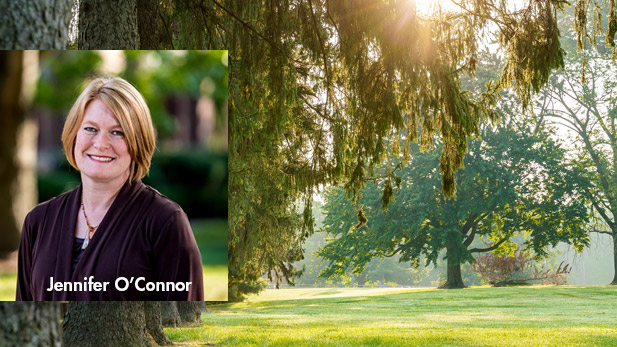Hulman Farm Property Serves as the Classroom for Evolution and Diversity Course

The Evolution and Diversity course allows students of all majors to study evolution, biodiversity and ecology in a course-based undergraduate experience with a research project component. Much of the course takes place outdoors, on the campus’ Hulman Farm property.
Across the street from the Rose-Hulman campus lies the Hulman Farm, an expansive array of grassy fields, wooded area, trees, wildlife and natural elements. During the fall quarter, it was also home to Professor Jen O’Connor’s evolution and diversity course. This hands-on class explores the study of evolution, biodiversity and ecology. Students spent time learning in this outdoor classroom, with hands-on activities including examining insects and soil elements to better understand the natural diversity within the West Central Indiana woods.
While O’Connor has been teaching this course on the main campus for 15 years, this is the first time she held the class outdoors in a natural setting. The addition of a crosswalk that linked the campus to the site made it possible to bring the students to the Hulman Farm property.
“We’re excited because as we develop this property, we can actually see the long term human impact … on this ecosystem and the species that live in it,” O’Connor says.
The evolution and diversity class is a 100-level biology course that is taken by both biology majors and non-majors. One of the reasons O’Connor loves teaching this class is that students, especially those who may not be in the biology major, have the opportunity for a learning experience in an outdoor, natural research setting and gain an understanding of how their fields of study have an environmental impact.
“So many students are studying engineering, and they will be doing things that have an impact on the environment,” she says. “They should think about the species that are in the environment and what the impact might be … [This class] might just give them a little bit to think about when they perform their engineering work.”
O’Connor also enjoys seeing how excited students get about being outdoors and seeing the various creatures in their natural elements. During the first few weeks of the class, students work in teams to collect insects and identify the varieties. O’Connor set up bird feeders to attract the avian species; however, due to the summer’s frequent rains, the feeders went untouched. As a result, students had to improvise and find different ways of identifying bird species. They did this by taking photos of birds in the sky and then listening to their calls and identifying them by sound.
Her students examined herbaceous plants, trees, fungi and mosses. They also used a trail camera to identify species that appeared at night and outside of class time, including deer, possum, birds and hawks. Students studied soil microbiome to identify bacteria living in West Central Indiana, and DNA from the soil was extracted and sent to labs for sequencing.
The students eventually took their observations and learnings and created biodiversity maps using the whiteboard app, identifying each species by their common and scientific names. The result was a large biodiversity map at the end of the term.
While students ultimately complete the class with an understanding of the diversity and evolution of the natural world, O’Connor believes some of the best teachable moments occur when things don’t go according to the research plan.
“I think a big part of scientific research is you do the work, and then you do it again to figure out if the method really worked well,” she said. “You then ask yourself, ‘Could this have been better?’ And so over time, we tweak our methods to make sure we get lots of data that we can use and study long term.”
The bird feeders not attracting birds was an example of what did not work for research, she believes. But that experience also enabled students to find other ways to learn what bird species inhabited the environment.
O’Connor’s future research endeavors include comparing the data that’s collected over the years to see what differences occur. She sees so much potential for the Hulman Farm to be further developed into a research site for the long term; not only for her class, but also for ecology, plant biology and microbiology classes as well.